
|   |

|   |
|
Magic in Moozhikulam - Veejay Sai e-mail: vs.veejaysai@gmail.com Images: Achuthan TK, Moozhikulam September 23, 2019 Last August, the India International Center in Delhi hosted a weeklong festival of Koodiyattam for the first time in their history, putting aside all their apprehensions about how the national capital might respond. Margi Madhu Chakyar and the artistes of his institution Nepathya in Moozhikulam performed 'Shoorpanakankam' to great acclaim. IIC never saw that kind of turnout of crowds for Koodiyattam. While this festival was hugely successful, Kerala was in news for all the wrong reasons. A massive natural disaster in the form of floods drowned entire districts across Kerala, affecting thousands of lives. Among the unfortunate victims were the residents of Moozhikulam. Water levels reached twelve feet drowning out entire houses. Nepathya's own Koothambalam, the houses of all the artistes were washed away. While Madhu kept a tab of the news, his only worry was the precious books of Koodiyattam, hand written manuscripts and such valuables, which were getting lost even as he was away performing in Delhi. Despite all that tension, Madhu gave a stellar performance in the role of Shoorpanakha. Back home in Moozhikulam with his team after the floods subsided, they realized they had lost everything. Whatever they had was the costumes they had taken with them to Delhi. They had to start from scratch. Anyone in their place would have been absolutely devastated. "We lost everything. Water had reached twelve feet high and whole localities were submerged. When I returned to see the Koothambalam, the green room behind where we stock our costumes, ornaments and make up was filled with thick mud. The crowns we wear normally are made of soft wood and weigh up to two or three kilograms. They were so soaked in the flood waters and mud, each of them was almost ten kilograms! In my house I lost everything. All the electronic gadgets like TV, washing machine, computer, fridge and everything in the ground floor! Nobody expected the water level would rise that high!" Margi Madhu tells me in an interview. As they gathered their strength to get back to normal, slowly help started pouring in. Chennai's ABHAI raised a small fund for them. Several other concerned individuals donated whatever they could. Normally, it would have taken half a dozen years to get back to normal. But Madhu is not someone to wait! Nor is his team! So this August, they hosted the 12th Koodiyattam festival with the same enthusiasm they have been for all these dozen years. The show must go on! 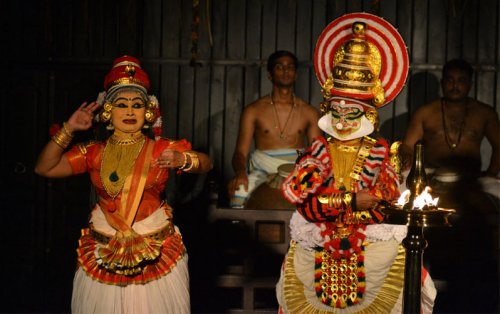 Moozhikulam on the banks of Chalakkudy River is an ancient little hamlet in the Chengamanad Panchayat in the Ernakulam district of Kerala. There are several versions of how this name came about. The Namboodhiri in the temple told me it was the place where Sage Hareetha got the darshan of Lord Vishnu who gave him Mantropadesham and hence 'Thirumozhi' Kalam, or a place where sacred words were spoken. Historian Keshavan Veluthat said it was called 'Moozhi Kalam', meaning a 'paddy field'; it changed over centuries to be called 'Moozhikulam'. Whatever be the etymology, the center of this village is the ancient temple of Lord Lakshmana Perumal and Madhuraveni Thaayar. Among the 108 Shri Vaishnava Divyadesams (holy places), Thirumoozhikulam is the 62nd. It is one of the 13 Divyadesams of the Chera Nadu. There are stone inscriptions going back to the tenth century inside the temple. There are Mangala Shaasanams by Nammazhwar and Thirumangai Azhwar to Lord Moozhikulathappan. There are at least fourteen Paasurams in the Naalayira Divyaprabandham. The temple also associates itself with the Ramayana. Four temples nearby are dedicated to the four brothers - the temple at Thriprayar for Lord Rama, Irinjalakkuda for Bharata, Payammal for Shatrugna and Moozhikulam for Lakshmana. Outside the main shrine under the Soundarya Vimanam, within the temple complex is a large ancient Koothambalam. The temple counts itself among the 'Naalambalam' Yatra. Devotees normally go on a 'Naalambala' yatra and visit all the four temples. The presence of these ancient Koothambalams inside these four temples is an indication of how integral Koodiyattam was to the temple rituals. Several families of Chakyars have offered their performances to gods over centuries! The Koothambalam outside the Lakshamana temple in Moozhikulam has its own history. The great Ammanur Madhava Chakyar's ancestors have had a history of performing here. More importantly, the great Moozhikulam Kochukuttan Chakyar performed there all his life. And his son is Margi Madhu Chakyar. So keeping up with his family tradition, Margi Madhu settled in this little temple town, serving this ancient art form like his ancestors did. 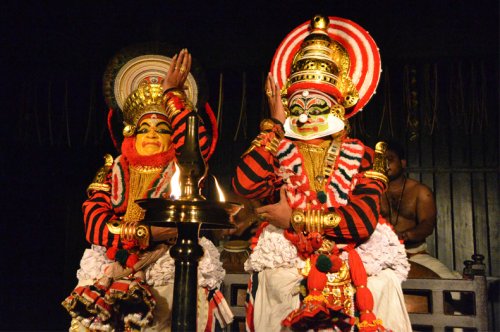 Margi Madhu-Sreehari as Bhima-Krodhavasa 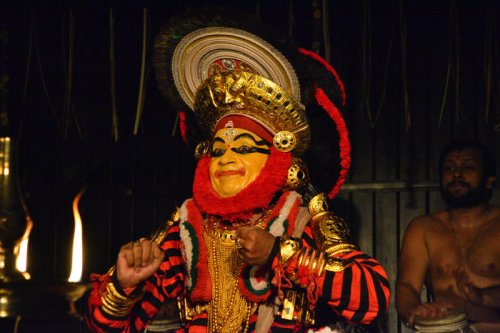 Margi Madhu as Bhima It is not easy to keep this art going. Madhu holds a day job at the Shankaracharya University in Kalady. It was here that he met Indu. Their common love for the art form gave birth to Nepathya. One of the first resolutions they took was never to compromise on tradition or fall for shortcuts. However difficult, they try to keep closest to the original format of how Koodiyattam is performed. Indu works as a teacher in a school nearby. Their collective salaries function like an oxygen pipe for Nepathya to survive. Despite all the financial problems, Nepathya has now trained four principal performers: Three students - Rahul Chakyar, the nephew of Madhu, Yadukrishnan, Vishnu Prasad - and Madhu's son Sreehari. Training in Koodiyattam is very different from how it works in other art forms. This extremely complex art requires mastery at different levels. Language, rhythm, music, dialogue delivery and many other facets of training take up a good decade and half of training for a student to debut. Currently all the students of Nepathya have been training for close to fifteen odd years. There are no scholarships for this kind of training. There are a few grants available from central government bodies, but those barely satisfy the needs of anything back home. Going by how erratic and unpredictable these grants come through, it is a miracle to see Nepathya survive all that. Like these problems aren't enough, there are newer ones Madhu and Nepathya face every other day with the rapid urbanization of where they stay. We were a witness to nasty neighbours who would burn red chillies outside their house, very close to the Koothambalam, so that the air would waft into the performance area, disturbing the artistes on stage with the hazardous smoke, often causing them to cough. 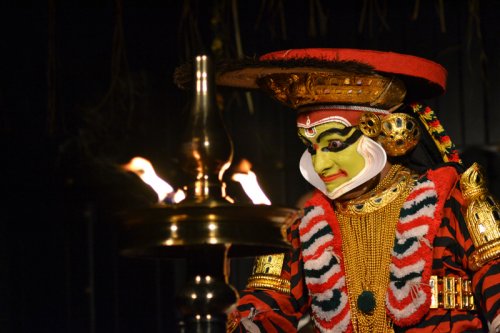 Yadukrishnan as Mayaraman 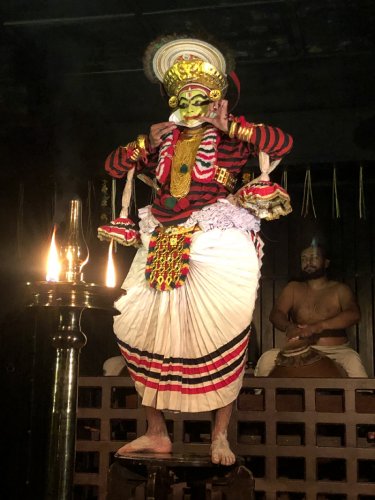 Rahul Chakyar as Mayaraman Despite all these obstacles, Madhu and Nepathya conducted their annual Koodiyattam Festival for the twelfth successful year. Spread over a fortnight, the festival showcased two plays. Neelakanta Kavi's 'Kalyanasaugandhikam' and 'Jataayuvadham', the fourth act of Shakti Bhadra's play 'Ascharyachoodamani'. I will not go into the details of the plays, as much of it is known and available. Watching the performances night after night, one can say that Koodiyattam is in safe hands, thanks to the brilliant artistes of Nepathya. The Hebrew University of Jerusalem and The European Research Council supported the festival. We had a bunch of research scholars headed by the eminent author and scholar Prof David Shulman and Prof Yigal Bronner. Their interest in Sanskrit and the fluency with which they were handling ancient texts would put many Indians to shame. An ideal day would see a class in the morning. All the students would gather at the Koothambalam. Margi Madhu and one of his students would go through the entire act for the day in great detail. Armed with iPads and modern gadgets, these scholars would take down notes and ask probing questions into the details of the play and its characters or discuss Sanskrit grammar. It was extremely fascinating to see a bunch of who would be termed as 'foreigners' feel completely at home with Sanskrit. Accommodation facilities are sparse in Moozhikulam. About ten minutes away from Nepathya's Koothambalam is the Moozhikulam Sala. Once a little gated community of Sama Veda practitioners, it is now modernized with little cottages that are rented out for a simple amount. All these research scholars were happy to adjust and stay in such conditions without any demands. We were also joined by Dr. Kesavan Veluthat, a retired professor of history with several books on Kerala with a special interest in Sanskrit, and Dr. Sudha Gopalakrishnan, the director of Sahapedia that was helping in the documentation of the festival. Their inputs into the morning classes were valuable. 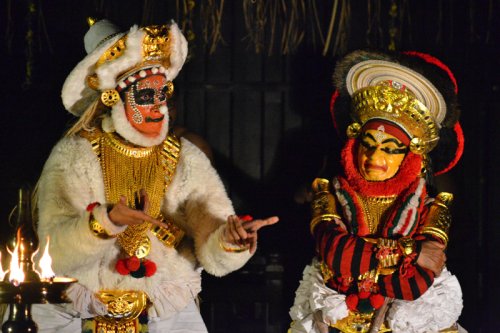 Yadukrishnan & Margi Madhu as Hanuman & Bhima In this day and age, nobody is doing this level of service to the art of Koodiyattam like Nepathya is. Not just creating awareness in academics, but through their performances, through their painstaking efforts in documentation and preservation, all this without any support. Nepathya and Margi Madhu need to be congratulated for everything they do to save the ancient art of Koodiyattam for posterity. For the ancient to survive, it requires the unflinching support of many like-minded in various forms. Every single effort in that direction is going to be a rewarding experience for the art form to thrive like it has in all these centuries. Veejay Sai is a writer, editor and culture critic. Response * A very fine, informative article. What an inspiring story! And even while l have met Madhu and his wife often, never have they complained about their state. I wish them all luck. They deserve it. - Leela Venkataraman (Sept 25, 2019) |